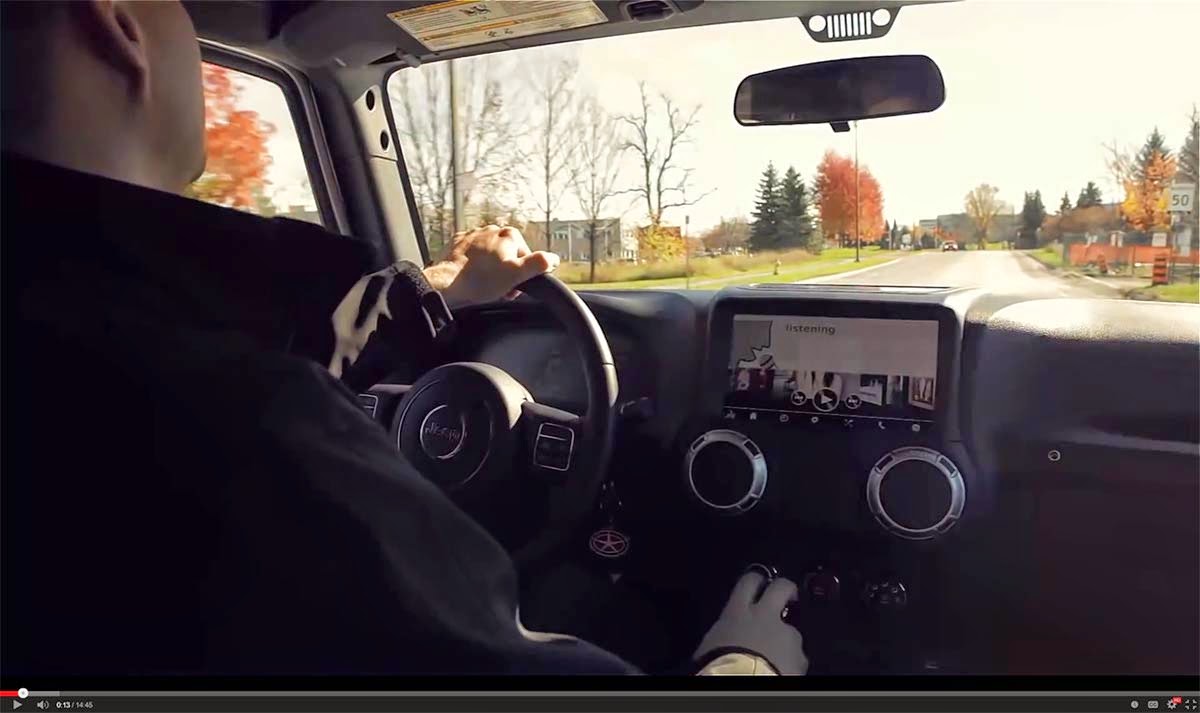 |
| Tina Jeffrey |
Since 2012, our Jeep has showcased what QNX technology can do out of the box. We decided it was time to up the ante...I walked into the QNX garage a few weeks ago and did a double take. The QNX reference vehicle, a modified Jeep Wrangler, had undergone a major overhaul both inside and out — and just in time for 2015 CES.
Before I get into the how and why of the Jeep’s metamorphosis, here’s a glimpse of its newly refreshed exterior. Orange is the new gray!

The Jeep debuted in June 2012 at Telematics Detroit. Its purpose: to show how customers can use off-the-shelf QNX products, like the QNX CAR Platform for Infotainment and QNX OS, to build a wide range of custom infotainment systems and instrument clusters, using a single code base.
From day one, the Jeep has been a real workhorse, making appearances at numerous events to showcase the latest HMI, navigation, speech recognition, multimedia, and handsfree acoustics technologies, not to mention embedded apps for parking, internet radio streaming, weather, and smartphone connectivity. The Jeep has performed dependably time and time again, and now, in an era where automotive safety is top of mind, we’ve decided to up the ante and add leading-edge ADAS technology built on the QNX OS.
After all, what sets the QNX OS apart is its proven track record in safety-certified systems across market segments — industrial, medical, and automotive. In fact, the QNX OS for Automotive Safety is certified to the highest level of automotive functional safety: ISO 26262, ASIL D. Using a pre-certified OS component is key to the overall integrity of an automotive system and makes system certification much easier.
The ultimate (virtual) driving experience How better to showcase ADAS in the Jeep, than by a virtual drive? At CES, a 12-foot video screen in front of the Jeep plays a pre-recorded driving scene, while the onboard ADAS system analyzes the scene to detect lane markers, speed signs, and preceding vehicles, and to warn of unintentional lane departures, excessive speed, and imminent crashes with vehicles on the road ahead. Onboard computer vision algorithms from
Itseez process the image frames in real time to perform these functions simultaneously.
Here’s a scene from the virtual drive, in which the ADAS system is tracking lane markings and has detected a speed-limit sign:

If the vehicle begins to drift outside a lane, the steering wheel provides haptic feedback and the cluster displays a warning:

The ADAS system includes Elektrobit
EB Assist eHorizon, which uses map data with curve-speed information to provide warnings and recommendations, such as reducing your speed to navigate an upcoming curve:

The Jeep also has a LiDAR system from
Phantom Intelligence (formerly Aerostar) to detect obstacles on the road ahead. The cluster displays warnings from this system, as well as warnings from the vision-based collision-detection feature. For example:
 POSTSCRIPT:
POSTSCRIPT: Here’s a short video of the virtual drive, taken at CES by Brandon Lewis of
Embedded Computing Design, in which you can see curve-speed warnings and lane-departure warnings:
Fast-boot cameraRounding out the ADAS features is a rear-view camera demo that can cold boot in 0.8 seconds on a Texas Instruments
Jacinto 6 processor. As you may recall, NHTSA has mandated that, by May 2018, most new vehicles must have rear-view technology that can display a 10-by-20 foot area directly behind the vehicle; moreover, the display must appear no more than 2 seconds after the driver throws the vehicle into reverse. Backup camera and other fastboot requirements such as time-to-last-mode audio, time-to-HMI visible, and time-to-fully-responsive HMI are critically important to automakers. Be sure to check out the demo — but don’t blink or you’ll miss it!
Full-featured infotainment The head unit includes a full-featured infotainment system based on the
QNX CAR Platform for Infotainment and provides information such as weather, current song, and turn-by-turn directions to the instrument cluster, where they’re easier for the driver to see.

Infotainment features include:
Qt-based HMI — Can integrate other HMI technologies, including
Elektrobit EB Guide and
Crank Storyboard.
Natural language processing (NLP) — Uses Nuance’s
Vocon Hybrid solution in concert with the QNX NLP technology for natural interaction with infotainment functions. For instance, if you ask “Will I need a jacket later today?”, the Weather Network app will launch and provide the forecast.
EB street director — Provides
embedded navigation with a 3D map engine; the map is synched up with the virtual drive during the demo.
QNX CAR Platform multimedia engine — An automotive-hardened solution that can handle:
- audio management for seamless transitions between all audio sources
- media detection and browsing of connected devices
- background synching of music for instant media playback — without the need for the synch to be completed
Support for all smartphone connectivity options — DLNA, MTP, MirrorLink, Bluetooth, USB, Wi-Fi, etc.
On-board application framework — Supports Qt, HTML5, APK (for Android apps), and native OpenGL ES apps. Apps include iHeart, Parkopedia, Pandora, Slacker, and Weather Network, as well as a Settings app for phone pairing, over-the-air software updates, and Wi-Fi hotspot setup.
So if you’re in the North Hall at CES this week, be sure to take a virtual ride in the QNX reference vehicle in Booth 2231. Beneath the fresh paint job, it’s the same workhorse it has always been, but now with new ADAS tech automakers are thirsting for.














































